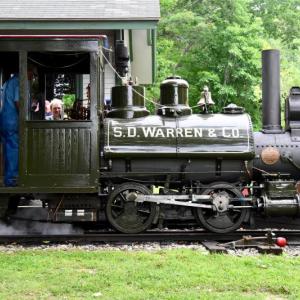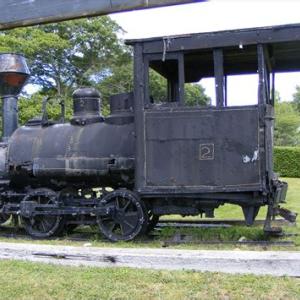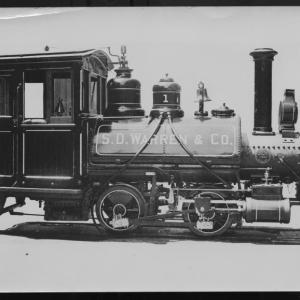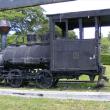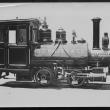1895 Baldwin locomotive from historic S.D. Warren Paper Mill restored to steam operation
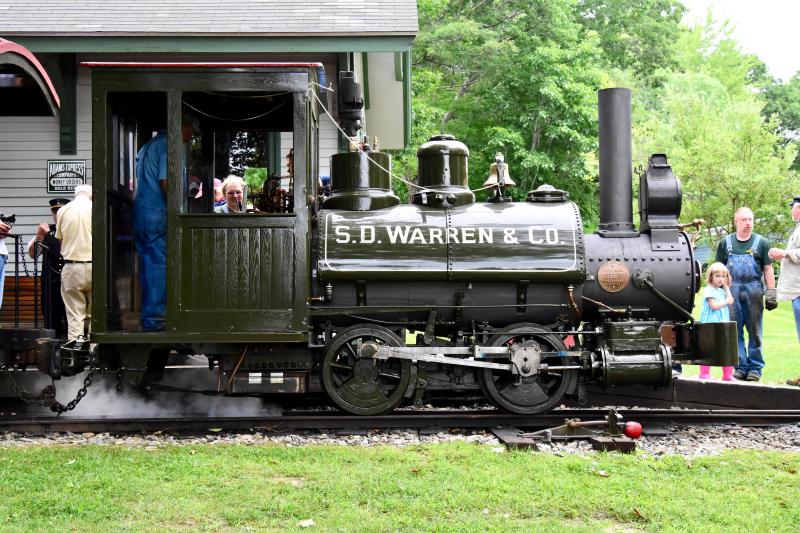 After nearly a decade of effort, S.D. Warren Baldwin No. 2 is returning to steam operation in Maine. When original parts were not salvageable, replacements were painstakingly recreated following the original orders and drawings obtained through the archives of Baldwin Locomotive Works and S.D. Warren. The public is invited to celebrate the completed restoration with a christening ceremony, illustrated talk, rides behind the engine and hands-on activities on Saturday, Sept. 8 at the Boothbay Railway Village. Bob Crink photo
After nearly a decade of effort, S.D. Warren Baldwin No. 2 is returning to steam operation in Maine. When original parts were not salvageable, replacements were painstakingly recreated following the original orders and drawings obtained through the archives of Baldwin Locomotive Works and S.D. Warren. The public is invited to celebrate the completed restoration with a christening ceremony, illustrated talk, rides behind the engine and hands-on activities on Saturday, Sept. 8 at the Boothbay Railway Village. Bob Crink photo
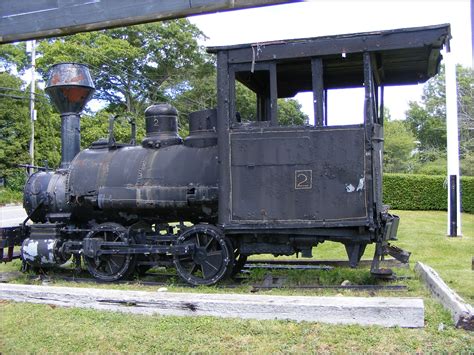 S.D. Warren Baldwin No. 2 sat under the Museum’s entrance sign on Route 27 from 1969 to 2008. Volunteers and staff who pulled the engine into the workshop nearly a decade ago often remark that she was more black paint and duct tape by the time the restoration began. Courtesy of BRV
S.D. Warren Baldwin No. 2 sat under the Museum’s entrance sign on Route 27 from 1969 to 2008. Volunteers and staff who pulled the engine into the workshop nearly a decade ago often remark that she was more black paint and duct tape by the time the restoration began. Courtesy of BRV
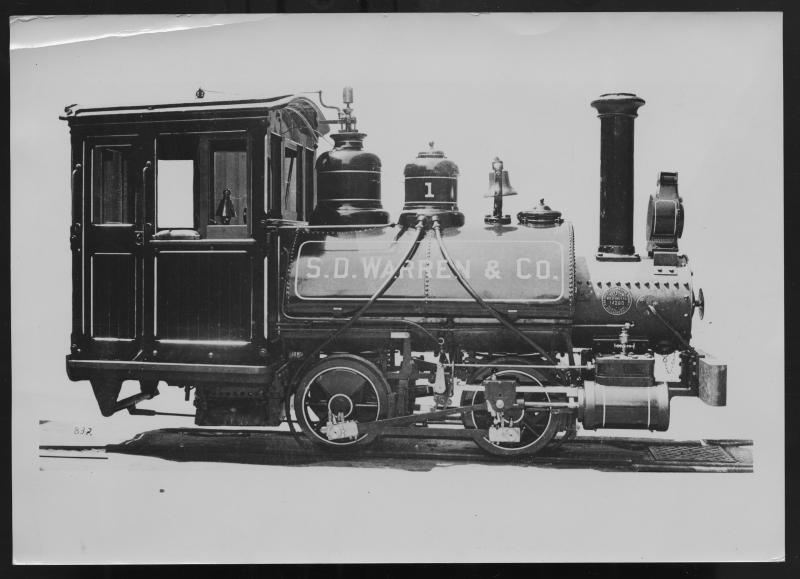 The 1895 builder’s photo of S.D. Warren Baldwin No. 1, the identical twin to No. 2. Builder’s photos were commonly taken as the engines rolled off the production line before being delivered to their owners. Courtesy of BRV
The 1895 builder’s photo of S.D. Warren Baldwin No. 1, the identical twin to No. 2. Builder’s photos were commonly taken as the engines rolled off the production line before being delivered to their owners. Courtesy of BRV
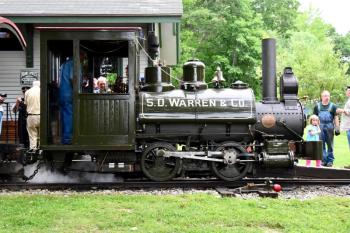 After nearly a decade of effort, S.D. Warren Baldwin No. 2 is returning to steam operation in Maine. When original parts were not salvageable, replacements were painstakingly recreated following the original orders and drawings obtained through the archives of Baldwin Locomotive Works and S.D. Warren. The public is invited to celebrate the completed restoration with a christening ceremony, illustrated talk, rides behind the engine and hands-on activities on Saturday, Sept. 8 at the Boothbay Railway Village. Bob Crink photo
After nearly a decade of effort, S.D. Warren Baldwin No. 2 is returning to steam operation in Maine. When original parts were not salvageable, replacements were painstakingly recreated following the original orders and drawings obtained through the archives of Baldwin Locomotive Works and S.D. Warren. The public is invited to celebrate the completed restoration with a christening ceremony, illustrated talk, rides behind the engine and hands-on activities on Saturday, Sept. 8 at the Boothbay Railway Village. Bob Crink photo
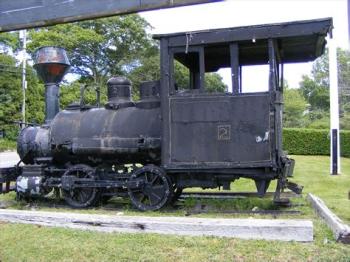 S.D. Warren Baldwin No. 2 sat under the Museum’s entrance sign on Route 27 from 1969 to 2008. Volunteers and staff who pulled the engine into the workshop nearly a decade ago often remark that she was more black paint and duct tape by the time the restoration began. Courtesy of BRV
S.D. Warren Baldwin No. 2 sat under the Museum’s entrance sign on Route 27 from 1969 to 2008. Volunteers and staff who pulled the engine into the workshop nearly a decade ago often remark that she was more black paint and duct tape by the time the restoration began. Courtesy of BRV
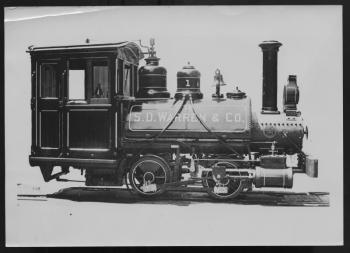 The 1895 builder’s photo of S.D. Warren Baldwin No. 1, the identical twin to No. 2. Builder’s photos were commonly taken as the engines rolled off the production line before being delivered to their owners. Courtesy of BRV
The 1895 builder’s photo of S.D. Warren Baldwin No. 1, the identical twin to No. 2. Builder’s photos were commonly taken as the engines rolled off the production line before being delivered to their owners. Courtesy of BRV
After a nearly a decade of effort by Museum staff and volunteers, S.D. Warren Co. locomotive No. 2 has been restored to its original operating condition, as built by the Baldwin Locomotive Works (Philadelphia, Pennsylvania) and shipped to Westbrook, Maine in 1895. Many might remember that this engine sat under the Museum’s entrance sign on Route 27 from 1969-2008. The restoration was made possible with financial support from the Amherst Railway Society, the Tom E. Dailey Foundation and many individuals. The public is invited to celebrate the completed restoration of S.D. Warren Baldwin No 2 with a christening ceremony, illustrated talk, rides behind the engine and hands-on activities on Saturday, Sept. 8 at the Boothbay Railway Village.
At 10:45 a.m. there will be an official ceremony marking the completion of the project and the engine’s return to service. Following the short ceremony, steam train departures powered by S.D. Warren Baldwin No 2 will depart every hour, on the hour from 11 a.m. to 4 p.m. At 1 p.m., Museum volunteer Ron Ginger will present an illustrated talk in the Spruce Point Chapel about the engine and its working life at both S.D. Warren and the Upper Saddle River Railroad along with stories from the nearly decade long restoration effort. Artist Jamie Wing will host drop-in, hands-on papermaking demonstrations inside the 1847 Boothbay Town Hall from 10 to 4, suitable for all ages.
The restoration of an industrial locomotive is a unique opportunity to highlight a segment of rail history that is often left out of the story of New England railroading. This locomotive, essentially a standard Baldwin industrial product along with identical sister No. 1, were part of the same order and replaced the horses at work in the mill yard. While it is commonly thought that the Sandy River Railroad was the first 2-foot narrow gauge railroad in Maine, the railroad in the mill (Cumberland Mills) was the earliest, although it did not have steam power until 1895. At the time steam power arrived at Cumberland Mills, S.D. Warren was producing more than 35,000 pounds of paper a day and was the largest paper mill in the world. No. 1 & No. 2 hauled both pulpwood and coal throughout the mill until they were replaced by diesel engines and trucks in the late 1940s. The mill complex was added to the National Register of Historic Places in 1974 as the Cumberland Mills Historic District. Today the paper making mill is owned by SAPPI Limited, a South African company.
Both S.D. Warren Baldwin engines survived thank to the efforts of the late Frank Van Walsh of Southport, Maine. Van Walsh bought the engines from S.D. Warren and took them to New Jersey. Van Walsh was a chemical engineer by day and an entrepreneur in his free time. There he refit them to run as gas engines at a small amusement park and zoo in Fair Lawn, just outside New York City. His family estimated that nearly two million guests visited his recreated narrow-gauge railroad, the Upper Saddle River Railroad, at Dietch’s Kiddie Zoo during the 20 years it was in operation. When Van Walsh retired to Maine in the late 1960s he donated the engines to the Boothbay Railway Village.
Locomotive No. 2 was built by the Baldwin Locomotive Works of Philadelphia, Pennsylvania in November 1895. The Baldwin Locomotive Works was founded in 1831 by Matthias Baldwin (1795-1866), a young Philadelphia metalworker who had constructed a miniature locomotive for the Philadelphia Museum. With its success, Matthias began receiving orders from many of the early railroads in the area not wishing to order their locomotives from England. In its early years Baldwin’s success was largely due to creating a standard locomotive product line. However, by the mid 1840s, the market had shifted to where each railroad ordered locomotives designed by themselves, and not the locomotive builder. Baldwin installed a system of standard parts to be used on various engine designs, minimizing design and manufacturing effort. Baldwin also insisted that parts be interchangeable, from locomotives of like design. This was a new concept, but it worked to his advantage. Even with all of this, Baldwin built most locomotives in their standard eight-week production cycle. Baldwin eventually grew into one of the largest employers in the country, having over 18,000 employees by 1907. Ultimately BLW became the largest locomotive builder in the world. Building over 70,000 locomotives by the early 1950s.
All but one of the narrow-gauge railroads of Maine had at least one Baldwin Locomotive. This was due to several factors, but most notably cost. Baldwin had developed clever ways to construct different locomotives to do different jobs, using a core of standard Baldwin parts. This kept construction costs low and delivery times fast, just what was needed in Maine. Although Baldwin engines were economical, they proved to be of high quality in both workmanship and material. Most of the Baldwin locomotives on the narrow-gauge railroads in Maine, were rebuilt over and over again during their long service lives, proving their value and ruggedness.
We are very fortunate that 4 of the 23 two-foot gauge Baldwin Locomotives built for service in Maine still exist. S.D. Warren & Co. No.’s 1 and 2 exist at the Boothbay Railway Village and Bridgton & Saco River No.’s 7 and 8 exist at the Maine Narrow Gauge Railroad in Portland. The restorations of both No.’s 2 and 7 have been completed in 2018.
All activities are included with Museum admission of $7 for children ages 3 to 18, $14 for adults, $12 for seniors (65+), children under 3 and Museum members are free. Standard admission also includes a second free day within seven days of your first visit. Although the Museum will be open from 10 to 5, most activities will take place between 11 and 4. Well-behaved and leashed four-legged friends are welcome. Contact the Boothbay Railway Village for more information at 633-4727, or online at www.railwayvillage.org. The Boothbay Railway Village is located at 586 Wiscasset Road, Route 27 in Boothbay, Maine.
Event Date
Address
United States

